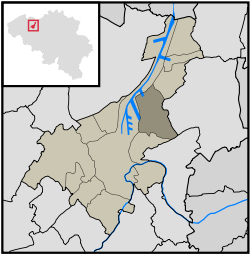- Oostakker
-
Oostakker — Deelgemeente — Coordinates: 51°06′01″N 3°45′48″E / 51.10028°N 3.76333°E Country Belgium Province  East Flanders
East FlandersMunicipality Ghent Area – Total 10.47 km2 (4 sq mi) Population (2007) – Total 12,793 – Density 1,222/km2 (3,165/sq mi) Source: NIS Postal code 9041 Oostakker, formerly spelled Oostacker, is one of the smaller former municipalities which were merged into Ghent (from which it is only two miles), the capital of the Belgian province of East Flanders. The hamlet is mainly known for its Roman Catholic shrine of the Virgin Mary.
Contents
Shrine of Oostakker
The miraculous shrine of the Blessed Virgin is a place of pilgrimage from Belgium, the Netherlands and Northern France. It takes its name from Ghent. Its origin as a centre of pilgrimage is comparatively recent, dating from 1873.
In 1871 the Marquise de Calonne de Courtebourne had built in the park of her estate at Oostacker an aquarium in the form of an artificial cave or grotto. One day, while on a visit to the park, the parish priest, reverend Moreels, suggested that a statue of Our Lady of Lourdes be placed among the rocks. For two years the grotto remained simply an aquarium, but gradually the members of the family formed the habit of stopping there to recite a Hail Mary. Soon it was decided to bless the statue publicly. The ceremony took place on 23 June 1873, and was attended by nearly all the inhabitants of the village. The pious Flemish peasants asked permission of the owner to come frequently to the park to give vent to their devotion. Accordingly, access was allowed them on Sunday afternoon. At that time the world was ringing with the fame of Lourdes, and the shrine at Oostakker soon became popular; marvelous graces and wonderful cures were reported.
Before long Sunday afternoon no longer sufficed to receive the throngs of pilgrims, and the park was thrown open to the public by the generous owner. Then a large Gothic church was built, the cornerstone being laid on 22 May 1875, by Mgr. Bracq. A priest's house followed, and the marchioness in memory of her son, a deceased Jesuit, confided shrine, church, and house to the Society of Jesus. The fathers took possession on 8 April 1877 and on 11 September of the same year the Apostolic nuncio, Seraphino Vannutelli, consecrated the church. That part of the estate, in which the grotto was, was now definitively given over to the service of Our Lady, a long avenue being built from the road to the shrine and a Way of the Cross erected. In the early 20th century 60,000 pilgrims came annually, in about 450 organized pilgrimages.
Gallery
Famous people
Stefaan Van Laare (1963) Writer
Sources
 This article incorporates text from a publication now in the public domain: Herbermann, Charles, ed (1913). Catholic Encyclopedia. Robert Appleton Company. [1]
This article incorporates text from a publication now in the public domain: Herbermann, Charles, ed (1913). Catholic Encyclopedia. Robert Appleton Company. [1]
External links
Categories:- Submunicipalities of Ghent
- Villages in Belgium
- Marian shrines
Wikimedia Foundation. 2010.



